Download CBSE Class 11 Biology Mineral Nutrition Notes Set B in PDF format. All Revision notes for Class 11 Biology have been designed as per the latest syllabus and updated chapters given in your textbook for Biology in Class 11. Our teachers have designed these concept notes for the benefit of Class 11 students. You should use these chapter wise notes for revision on daily basis. These study notes can also be used for learning each chapter and its important and difficult topics or revision just before your exams to help you get better scores in upcoming examinations, You can also use Printable notes for Class 11 Biology for faster revision of difficult topics and get higher rank. After reading these notes also refer to MCQ questions for Class 11 Biology given on studiestoday
Revision Notes for Class 11 Biology Chapter 12 Mineral Nutrition
Class 11 Biology students should refer to the following concepts and notes for Chapter 12 Mineral Nutrition in Class 11. These exam notes for Class 11 Biology will be very useful for upcoming class tests and examinations and help you to score good marks
Chapter 12 Mineral Nutrition Notes Class 11 Biology
PointsTo Remember
Autotroph: An organism that sythesize its required nutrients from simple and inorganic substance; Example-plants, blue green algae (cyanobacteria)
Heterotroph : An organism that cannot synthesise its own nutrients and depend on others. Example-Bacteria, protists, members of animalia.
Biological nitrogen fixation: Conversion of atmospheric nitrogen into organic compounds by living organisms.
Chlorosis: Yellowing ofleaves due to loss of chlorophyll.
Nitrification : Conversion of ammonia (NH3) into nitrite and then to nitrate.
Denitrification : A process of conversion of nitrate into nitrous oxide and nitrogen gas (N2).
Leg-hemoglobin : Pinkish pigment found in the root nodules of legumes.
It acts as oxygen scavenger and protects the nitrogenase enzyme from oxidation.
Flux : The movement of ions is called flux. Influx is inward movement of ions into the cells and efflux is the outward movement of ions.
Inhibition of cell division : Deficiency ofN, K, S. and Mo.
Necrosis : Death of tissues particularly leaf tissue due to deficiency of Ca, Mg, Cu, K.
Delayed Flowering: due to deficiency ofN, S, Mo.
Mineral Nutrition : Plants require mineral elements for their growth and development. The utilization of various absorbed ions by a plant for growth and development is called mineral nutrition of the plant.
Hydroponics : Soil-less culture of plants, where roots are immersed in nutrient solution (without soil) is called hydroponics. The result obtained from hydroponics may be used to determine deficiency symptoms of essential elements.
Active Transport : Absorption occuring at the expense of metabolic energy.
Passive Transport : Absorption of minerals with concentration gradient by the process of diffusion without the expense of metabolic energy.
Essential Elements

In addition to the 17 essential elements, Na, Si, Co and Si are required by some higher plants.
Criteria for essentiality:
The element must be necessary for supporting normal growth and reproduction.
Requirement must be specific and not replaceable by another element.
The element must be directly involved in the metabolism of the plant.
Role of Minerals Elements in Plants
MACRO NUTRIENTS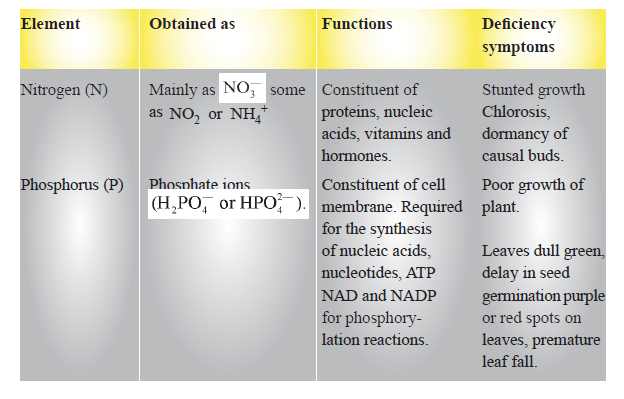
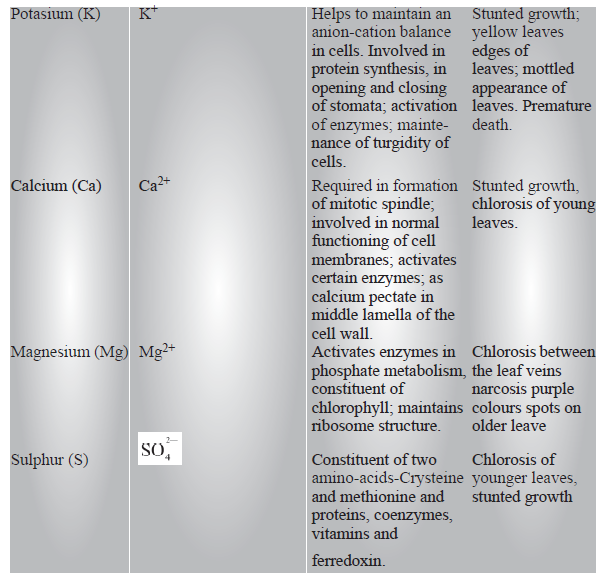
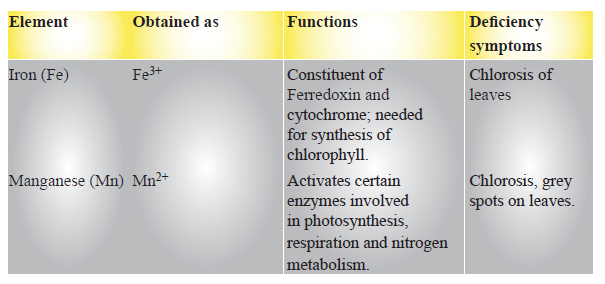

Critical Concentration : The concentration of the essential element below which plant growth is retarted. The element is said to be deficient when present below the critical concentration.
Deficiency symptoms : Chlorosis, stunted growth, premature fall of leaves and buds and inhibition of cell division.
Toxicity of micronutrient : Any mineral ion concentration in tissues that reduces the dry weight of tissues by 10% is considered toxic. Toxicity of one element may lead to deficiency of other element since the former may inhibit the uptake of latter., e.g., Mn competes with Fe, Mg for uptake and also inhibits Ca translocation to shoot apex. Therefore Mn toxicity symptoms are actually same as deficiency symptoms ofFe, Mg and Ca.
Role of microbes in nitrogen cycle :
Rhizobium, Azotobacter, Rhodospirillum; Fix atmospheric nitrogen
Nitrosomonas and/or Nitrococcus :-Conversion of ammonia to nitrite
Nitrobacter : Conversion of nitrite into nitrate.
Pseudomonas and Thiobacillus : reduce nitrate into nitrogen.
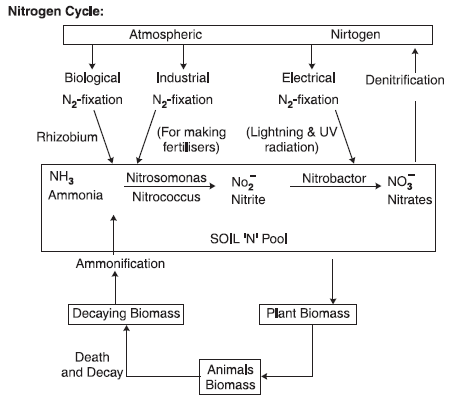
Nitrogen fixation-The process of conversiOn of Nitrogen (N2) into ammonia (NH3).
Ammonification-The process of decomposition of organic nitrogen of plants and animals (proteins) into ammonia.
![]()
Nitrification-The ammonia so formed may volatilise and re-enter the atmosphere, or some of the ammonia may be converted first into nitrite and then into nitrate by soil bacteria

The Nitrate so formed can be easily absorbed by the plants and transported to leaves. In leaves, nitrate is reduced to ammonia to form amino-acids, because nitrate can not used by plants as such.

Denitrification-Process of reduction of the nitrate present in soil to nitrogen. It is carried out by bacteria like Pseudomonas and Thiobacillus.
Biological Nitrogen Fixation-Reduction of nitrogen to ammonia by living organisms. Certain prokaryotes are able to fix nitrogen because of presence of ‘nitrogenase’ enzyme in them.
Nitrogen fixing microbes may be
(a) Free living-(i) Aerobic-Azotobacter
(ii) Anaerobic-Rhodospirillum
(b) Cyanobacteria-Nostoc, Anabaena
(c) Symbiotic-(i) With leguminous plants-Rhizobium
(ii) With non-leguminous plants-Frankia
Enzyme nitrogenase-The enzyme nitrogenase is Mo-Fe protein and catalysis the conversion of atmospheric nitrogen to ammonia (First stable product of nitrogen fixation)
Leg-hemoglobin-A pink colour pigment, similar to hemoglobin of vertebrates and functions as an oxygen scavenger and protects nitrogenase from oxygen.
![]()
Mineral Nutrition
Steps of nodule formation :
(a) Rhizobium bacteria present in soil contact a susceptible root hair.
(b) Infection of the root hair cause it to curve and deformed due to chemical secretion.
(c) An infection thread is produced carrying the bacteria into the cortex of the root.
(d) The bacteria get modified into rod-shaped bacteria and cause inner cortical and pericycle cells to divide plant produce cytokinin and auxin to stimulate cell division and enlarge to form nodules.
(e) Division and growth of cortical and pericycle cells lead to nodule formation.
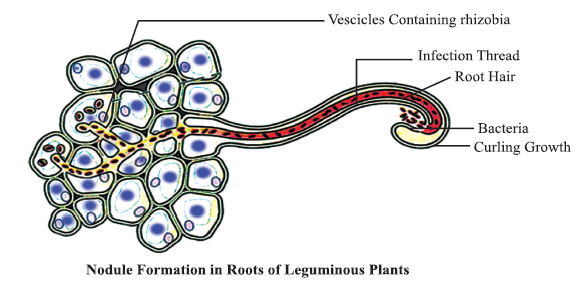
Mechanisms ofN2 fixation
It require 3 components-
(a) A strong reducing agent like FADH2, NADPH2
(b) Nitrogenase enzyme
(c) ATP (as energy service)
Steps
(a) Formation ofDiamide
(b) Formation ofHydrazine (N2H4)
(c) Formation of Ammonia
| CBSE Class 11 Biology The Living World Notes Set A |
| CBSE Class 11 Biology The Living World Notes Set B |
| CBSE Class 11 Biology Plant Kingdom Notes Set A |
| CBSE Class 11 Biology Plant Kingdom Notes Set B |
| CBSE Class 11 Biology Plant Kingdom Notes Set C |
| CBSE Class 11 Biology Animal Kingdom Notes Set A |
| CBSE Class 11 Biology Animal Kingdom Notes Set B |
| CBSE Class 11 Biology Animal Kingdom Notes Set C |
| CBSE Class 11 Biology Morphology Of Flowering Plants Notes Set A |
| CBSE Class 11 Biology Morphology Of Flowering Plants Notes Set B |
| CBSE Class 11 Biology Structural Organisation In Animals Notes Set A |
| CBSE Class 11 Biology Structural Organisation In Animals Notes Set B |
| CBSE Class 11 Biology Cell The Unit Of Life Notes Set A |
| CBSE Class 11 Biology Cell The Unit Of Life Notes Set B |
| CBSE Class 11 Biology Cell The Unit Of Life Notes Set C |
| CBSE Class 11 Biology Biomolecules Notes Set A |
| CBSE Class 11 Biology Biomolecules Notes Set B |
| CBSE Class 11 Biology Respiration In Plants Notes Set A |
| CBSE Class 11 Biology Respiration In Plants Notes Set B |
| CBSE Class 11 Biology Plant Growth And Development Notes Set A |
| CBSE Class 11 Biology Plant Growth And Development Notes Set B |
| CBSE Class 11 Biology Breathing And Exchange Of Gases Notes Set A |
| CBSE Class 11 Biology Breathing And Exchange Of Gases Notes Set B |
| CBSE Class 11 Biology Body Fluids And Circulation Notes Set A |
| CBSE Class 11 Biology Body Fluids And Circulation Notes Set B |
| CBSE Class 11 Biology Neural Control And Coordination Notes Set A |
| CBSE Class 11 Biology Neural Control And Coordination Notes Set B |
| CBSE Class 11 Biology Chemical Coordination and Integration Notes Set A |
| CBSE Class 11 Biology OTBA Guidance Document Set A |
| CBSE Class 11 Biology OTBA Guidance Document Set B |
CBSE Class 11 Biology Chapter 12 Mineral Nutrition Notes
We hope you liked the above notes for topic Chapter 12 Mineral Nutrition which has been designed as per the latest syllabus for Class 11 Biology released by CBSE. Students of Class 11 should download and practice the above notes for Class 11 Biology regularly. All revision notes have been designed for Biology by referring to the most important topics which the students should learn to get better marks in examinations. Our team of expert teachers have referred to the NCERT book for Class 11 Biology to design the Biology Class 11 notes. After reading the notes which have been developed as per the latest books also refer to the NCERT solutions for Class 11 Biology provided by our teachers. We have also provided a lot of MCQ questions for Class 11 Biology in the notes so that you can learn the concepts and also solve questions relating to the topics. We have also provided a lot of Worksheets for Class 11 Biology which you can use to further make yourself stronger in Biology.
You can download notes for Class 11 Biology Chapter 12 Mineral Nutrition for latest academic session from StudiesToday.com
Yes, the notes issued for Class 11 Biology Chapter 12 Mineral Nutrition have been made available here for latest CBSE session
There is no charge for the notes for CBSE Class 11 Biology Chapter 12 Mineral Nutrition, you can download everything free of charge
www.studiestoday.com is the best website from which you can download latest notes for Chapter 12 Mineral Nutrition Biology Class 11
Come to StudiesToday.com to get best quality topic wise notes for Class 11 Biology Chapter 12 Mineral Nutrition

